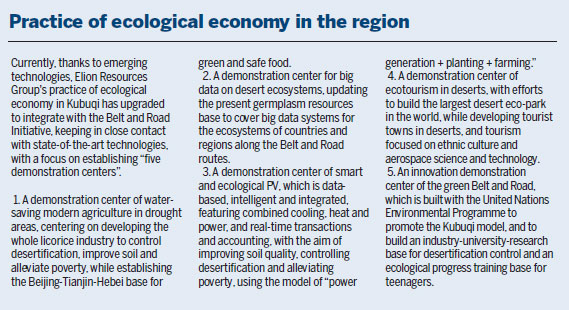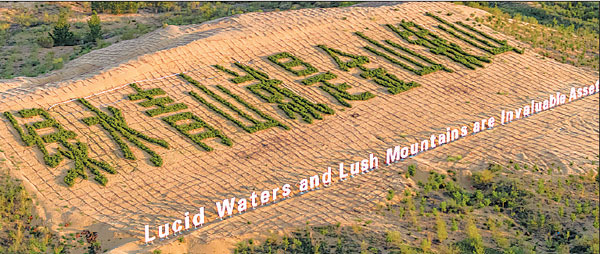Green desert economics: drawing on Kubuqi experiences
Desertification has become one of the major challenges afflicting 2.1 billion people in 167 countries and regions across the globe.
China is among the countries severely affected by desertification, with some part of its land area covered and one third of its population threatened by deserts.
Growing up on the periphery of deserts, I suffered when I was young, and wanted desperately to escape the vast expanse of sand.
Combating deserts for over 30 years since the 1980s, I have learned significantly from my experiences and have developed the concept of desert economics.
Traditionally, desert is regarded as the original sin that causes all the problems in the region: sandstorms, ecological degradation, poverty, diseases, and even social conflicts and turmoil.
I kept asking myself: "Can't the desert provide any opportunity or potential to benefit the well-being of people, rather than only causing problems?"

As a young man, I used to gaze at the starry sky over the desert, which aroused a kind of reverence in me. I began to ponder seriously the idea of developing desert economics.
I have come to realize that the desert should not be a human burden, but a part of the integrated ecosystem of the Earth and a huge deposit of treasure waiting to be exploited.
As long as we respect, be friendly with and protect nature, and treat the desert with the vision of sustainable development, the desert will provide us with opportunities.
When the Kubuqi Desert where I grew up is covered with green mountains with clear waters, the "silver and gold mountains" will surely come.
The past 30 years of practice in desertification control and development of the desert green economy in Kubuqi are rooted in the concept of desert economics, the core of which lies in these key concepts:
(1) Deserts can be brought under control to grow green food and green assets, with challenges turned into opportunities.
(2) Extensive and long-term efforts should be made to combat sands, with overall planning to ultimately establish oases in deserts through an improved eco-environment, biodiversity and microclimate, enabling the achievement of well-balanced ecosystem development.
(3) The efforts to combat desertification should be made economically profitable, industry-based, market-oriented and nature-friendly, following the principles of the green desert economy to transform challenges into opportunities, and negative assets into green assets that contribute to GDP growth.
(4) The efforts to combat desertification should be supported by innovative technologies, including new technologies in seed breeding, water saving, and soil improvement, as well as advanced technologies in green agriculture and related industries.
(5) Innovative concepts and systems are required in taking action against desertification to establish a multilateral mechanism featuring the joint engagement of government, businesses, and farmers and herdsmen, to form an eco-industry-specific operating model that is market-oriented and industry-based for the benefit of the public well-being.
As the seventh-largest desert in China with a total area of 18,600 square kilometers, the Kubuqi Desert - the closest desert to Beijing - used to be one of the three major sources of sandstorms hitting the Beijing-Tianjin-Hebei province region.
In the 1980s, when I began to work at a small salt factory in the heart of the Kubuqi Desert, I embarked on the journey of combating deserts, though I suffered repeated failures.
Then I became aware that desertification control must not be taken as fighting tit-for-tat against an enemy. Instead, we should respect the desert and adapt to it.
This is how and why I have developed and practiced the concept of desert economics.
We have afforested the once barren and lifeless deserts, expanded a dying business, and improved the livelihoods of the local poverty-stricken residents.
When I look back into the past decades, I am convinced that these achievements would never have been possible without the policy support from the government at all levels, as well as the wide engagement of local people in desert areas.
Thirty years of experience has proved the effectiveness of the balanced development models of desertification control, eco-restoration, industrial development and livelihood improvement.
We aim to turn deserts into green and usable land, collect fresh water from the rain, and generate electricity from sunlight, simultaneously improving the desert environment and people's financial benefits, desert ecosystems and industrial development, and desertification control and business prosperity.
To date, our group has expanded and diversified its business in ecosystem recovery to solve four ecological problems, three on land and one related to rivers, namely, desertification, stony desertification, salinization and riverbed degradation.
We have extended our footprint from the Inner Mongolia autonomous region to the Beijing-Tianjin-Hebei area, the Xinjiang Uygur and Tibet autonomous regions, and Gansu, Yunnan, Guizhou, and Qinghai provinces, and even further to countries and regions along the Belt and Road such as Saudi Arabia, Egypt and Australia.
We explore to seek truth, and we are always ready to share the Kubuqi model and our experience, which are improving and maturing day by day, with other countries across the world, so that we can make our due contributions to the building of the green Belt and Road Initiative and the fulfillment of the United Nations target of zero net land degradation by 2030.
The author is the chairman of Elion Resources Group, a green technology and finance company.
|
A good natural environment in deserts is a goal as important as economic benefits in China.Provided To China Daily |
(China Daily 09/09/2017 page12)















